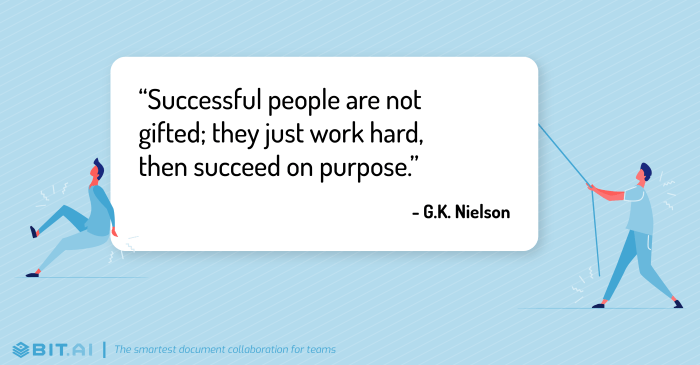How to be honest with yourself and get more done is a powerful concept. It’s about understanding your true self, identifying your values, setting realistic goals, and managing your time effectively. This isn’t just about to-do lists and productivity hacks; it’s about aligning your actions with your authentic self for a more fulfilling and productive life.
By being honest with yourself, you gain clarity on your strengths and weaknesses, allowing you to set achievable goals and prioritize tasks effectively. This approach fosters a deep understanding of your needs and motivates you to work toward them, ultimately leading to greater productivity and satisfaction.
Understanding Honesty with Yourself
Honesty is a cornerstone of personal growth and success. But there’s a critical form of honesty that often gets overlooked: honesty with ourselves. This self-awareness isn’t about harsh self-criticism, but rather about accurately assessing our strengths, weaknesses, motivations, and biases. This allows us to make informed decisions and pursue goals aligned with our true selves. Ignoring these aspects can lead to frustration and wasted effort.Self-honesty, unlike social honesty, focuses on the internal landscape of our thoughts, feelings, and actions.
It’s about recognizing our motivations, even when they are uncomfortable or inconvenient. It’s the bedrock upon which meaningful progress is built. Without this self-awareness, we may find ourselves pursuing goals that don’t truly resonate with our values or capabilities. This leads to decreased motivation and a feeling of being stuck.
Defining Self-Honesty
Self-honesty involves a deep and unbiased understanding of our true selves. It means acknowledging our strengths, weaknesses, values, and limitations without judgment. It’s not about perfection, but about truth. This is distinct from social honesty, which focuses on being truthful in interactions with others. Self-honesty is an internal process of self-reflection and evaluation.
It’s a journey of understanding and acceptance.
Importance of Self-Honesty in Goal Achievement
Self-honesty is crucial for setting realistic and attainable goals. When we are honest with ourselves about our capabilities and limitations, we can tailor our goals accordingly. We avoid setting ourselves up for disappointment by recognizing our current state. This leads to more sustainable progress and greater fulfillment.
Obstacles to Self-Honesty
Several obstacles can hinder our ability to be honest with ourselves. These include fear of failure, denial, and self-deception.
- Fear of Failure: This fear can paralyze us, preventing us from acknowledging our weaknesses or limitations. This can manifest as avoidance of difficult tasks or a reluctance to confront our shortcomings. Overcoming this fear involves reframing failure as a learning opportunity. Instead of seeing it as a personal defeat, view it as a stepping stone toward improvement.
- Denial: This involves refusing to acknowledge unpleasant truths about ourselves. We may rationalize our actions or downplay our weaknesses. Facing denial requires confronting these uncomfortable truths with courage and self-compassion. Self-reflection and seeking feedback from trusted sources can be powerful tools.
- Self-Deception: This involves intentionally misleading ourselves about our motivations or capabilities. This often stems from a desire to avoid facing difficult emotions or challenges. Recognizing self-deception involves paying close attention to our patterns of thought and behavior. Identifying and questioning these patterns can help to expose the truth.
Strategies for Recognizing Biases and Motivations
Identifying our biases and motivations is essential for self-honesty. We often have unconscious biases that influence our decisions and actions.
- Self-Reflection: Regularly engaging in self-reflection allows us to identify our patterns of thought and behavior. This includes journaling, meditation, and mindfulness practices. The goal is to be introspective and observe ourselves without judgment.
- Seeking Feedback: Seeking feedback from trusted sources, such as mentors, friends, or family, can provide valuable insights into our strengths and weaknesses. It’s crucial to be open to constructive criticism and to use it to guide our self-improvement.
- Mindfulness Practices: Mindfulness involves paying attention to the present moment without judgment. This can help us to become more aware of our thoughts, feelings, and behaviors as they arise. This awareness can lead to more honest self-assessment.
Self-Honesty and Emotional Intelligence
Self-honesty is a key component of emotional intelligence. It involves understanding and managing our own emotions, as well as recognizing and responding to the emotions of others. Self-awareness is the cornerstone of both. It allows us to identify our emotional triggers and responses, leading to more effective interpersonal relationships.
Comparing Self-Reflection Approaches
| Approach | Description | Strengths | Limitations |
|---|---|---|---|
| Journaling | Writing down thoughts and feelings | Promotes introspection, tracks progress, helps identify patterns | Can be time-consuming, may not address deeper emotions |
| Meditation | Focusing on the present moment | Reduces stress, cultivates awareness, enhances self-understanding | Requires practice and discipline, may not be suitable for all |
| Mindfulness | Paying attention to present moment experiences | Promotes awareness of thoughts and feelings, improves self-regulation | Requires conscious effort, can be challenging to sustain |
Identifying Your Values and Priorities
Knowing your core values is crucial for aligning your actions with your personal goals and overall well-being. This understanding empowers you to make choices that feel authentic and meaningful, leading to increased productivity and satisfaction. By prioritizing tasks based on these values, you can focus on what truly matters to you, reducing stress and maximizing your efforts.Understanding your values is a journey of self-discovery.
It’s not about finding the “perfect” set of values, but rather recognizing the principles that guide your decisions and motivate your actions. By understanding these values, you can make conscious choices that support your personal growth and fulfillment.
Defining Core Values
Identifying your core values involves reflecting on the principles that are most important to you. These aren’t fleeting preferences, but deeply held beliefs that influence your decisions and actions. Consider what aspects of life bring you a sense of purpose and fulfillment. Are they related to relationships, creativity, achievement, helping others, or something else entirely? This process requires introspection and honest self-assessment.
Methods for Prioritizing Tasks
Once you’ve identified your core values, you can use them as a framework for prioritizing tasks and activities. This involves aligning your daily actions with the values you deem most important. By consistently making choices that reflect your values, you build a sense of purpose and integrity.
- Consider the impact of each task. Does it align with your core values? If a task aligns with a high-priority value, it likely deserves more of your time and attention.
- Break down large tasks into smaller, manageable steps. This approach allows you to focus on individual actions and track progress. It’s easier to remain motivated when you can see clear markers of progress.
- Schedule time for activities that align with your values. Treat these activities as non-negotiable commitments. Allocate specific times for them, and stick to the schedule as much as possible.
- Evaluate your progress regularly. Assess how your daily actions are reflecting your values. Are you staying on track? If not, make adjustments to better align your choices with your core values.
Values and Personal Goals
Your values often serve as the foundation for your personal goals. They provide a roadmap for what you want to achieve and how you want to live your life. For example, if a core value is creativity, your personal goals might include taking art classes, writing a novel, or starting a blog. The connection between values and goals is vital for motivation and fulfillment.
Aligning Daily Actions with Values
Regularly reflecting on your values can help you align your daily actions with them. Consider how each choice you make relates to your core values. For example, if helping others is a core value, volunteering or donating to a cause you care about could be a daily action that reflects this. This process involves a conscious effort to make choices that resonate with your personal values.
Questions to Determine Core Values
These questions can help you determine your core values:
- What qualities do you admire most in others?
- What situations make you feel most passionate and energized?
- What activities bring you a sense of purpose and fulfillment?
- What are your biggest achievements, and what values were involved in those accomplishments?
- What principles do you find yourself consistently defending or advocating for?
Prioritization Table
| Value | Example Tasks | Priority Level (High/Medium/Low) |
|---|---|---|
| Creativity | Writing a story, painting, composing music | High |
| Helping Others | Volunteering at a local shelter, mentoring a student | High |
| Learning | Taking a course, reading a book, attending a workshop | Medium |
| Financial Security | Budgeting, saving money, investing | Medium |
| Health and Well-being | Exercising, eating healthy, getting enough sleep | High |
Setting Realistic Goals and Expectations
Honesty with yourself means acknowledging your current abilities and limitations. This crucial step allows you to set goals that are achievable and contribute to sustained progress, rather than leading to frustration and discouragement. Without realistic expectations, you’re more likely to experience burnout and give up on your aspirations.Realistic goals are not just about lowering your ambitions; they’re about aligning your aspirations with your current capabilities and the resources you have available.
This approach fosters a sense of accomplishment and encourages continued effort. It’s about building momentum towards your long-term objectives through a series of manageable steps.
Establishing Realistic Goals
Setting realistic goals begins with a thorough self-assessment. Identify your strengths and weaknesses, your current resources (time, energy, skills), and the external factors that might impact your progress. Consider your past experiences and the lessons you’ve learned. Don’t be afraid to start small. A series of small, achievable wins builds confidence and motivates you to continue.
This avoids overwhelming yourself with tasks that feel insurmountable.
Breaking Down Large Goals
Large goals can feel daunting. Breaking them down into smaller, more manageable steps makes them less intimidating and more attainable. This process, often referred to as “chunking,” allows you to track your progress more effectively and celebrate milestones along the way.
“A journey of a thousand miles begins with a single step.”
Lao Tzu
For example, instead of aiming to write a novel, break it down into writing a certain number of words each day. This approach fosters a sense of accomplishment and reduces the feeling of being overwhelmed.
Overcoming Procrastination and Maintaining Motivation
Procrastination is a common obstacle to achieving goals. Identifying the root causes of procrastination (e.g., fear of failure, perfectionism, lack of clarity) and addressing them directly is key. Strategies for maintaining motivation include setting realistic deadlines, rewarding yourself for progress, and surrounding yourself with supportive people. Regular self-reflection can help you identify what’s working and what’s not.
Figuring out how to be honest with yourself and get more done can feel tough, but sometimes a change of scenery is just what you need. Check out these 40 fun winter activities you can try now here to spark some new ideas and boost your motivation. Once you’ve tried a few, you’ll find that honesty with yourself about what you enjoy and what you’re capable of doing will help you focus your energy and accomplish more, no matter the season.
Adjusting your approach as needed keeps you on track.
Adjusting Goals When Faced with Challenges
Unexpected challenges are inevitable. Adaptability is crucial for navigating these obstacles. Be prepared to adjust your goals or timelines if necessary. Don’t be afraid to change your course if a new approach proves more effective. The important thing is to stay focused on your overall objectives.
The Concept of “Enough” and Avoiding Perfectionism
Perfectionism often leads to inaction. Striving for perfection can be paralyzing. Accepting “good enough” is an important step in achieving goals. Focusing on progress, rather than flawlessness, fosters a sense of accomplishment and prevents you from getting stuck in a cycle of self-criticism. Acknowledge that progress is often measured in increments.
Comparing Short-Term and Long-Term Goals
| Characteristic | Short-Term Goals | Long-Term Goals |
|---|---|---|
| Timeframe | Days to weeks | Months to years |
| Scope | Specific, focused tasks | Broader objectives |
| Strategies | Daily action plans, immediate rewards | Long-term planning, strategic investments |
| Examples | Finish a chapter, complete a project, learn a new skill | Achieve a degree, start a business, travel the world |
| Measurement | Tangible progress, immediate feedback | Cumulative progress, long-term evaluation |
Short-term goals provide momentum and build confidence. Long-term goals provide direction and purpose. A balanced approach that integrates both is crucial for sustained progress. Be sure to review and adjust your goals regularly.
Managing Time Effectively and Avoiding Distractions
Honesty with yourself extends beyond your values and goals. It also encompasses your ability to manage your time realistically. Understanding how you spend your time is crucial for productivity. Recognizing and eliminating time-wasting activities frees up valuable hours for pursuing your priorities. This section provides practical strategies for effective time management, focused work environments, and navigating multiple priorities.Effective time management is not about squeezing more into less time, but about making the most of the time you have.
It’s about strategically allocating your energy and resources to maximize output and minimize wasted effort. This involves recognizing and eliminating distractions, creating a conducive work environment, and understanding your personal time management style.
Effective Time Management Techniques
Effective time management techniques are crucial for maximizing productivity. They provide structure and guidance, enabling you to allocate time efficiently to different tasks. Different techniques cater to varying preferences and work styles. Experimenting with various approaches is key to discovering what works best for you.
- The Pomodoro Technique: This technique involves working in focused intervals (typically 25 minutes) followed by short breaks. This structured approach helps maintain concentration and prevents burnout. Regular breaks help to maintain focus and avoid fatigue. The short bursts of work with short breaks are designed to maintain concentration and improve overall productivity. The intervals are specifically designed to prevent prolonged periods of concentration and the potential for burnout.
- Time Blocking: Scheduling specific time slots for particular tasks. This approach provides a visual representation of your daily schedule, allowing you to allocate time effectively and prioritize tasks. This approach allows you to visualize your daily schedule, allocating specific time blocks for different tasks. This helps to create a clear structure for your day and manage your time effectively.
For example, you might block out an hour for writing, and another for responding to emails.
- The Eisenhower Matrix: Categorizing tasks based on urgency and importance. This method helps prioritize tasks, focusing on high-impact activities while delegating or eliminating less important ones. The Eisenhower Matrix is a time management tool that helps prioritize tasks based on urgency and importance. This method helps to distinguish between urgent and important tasks, which is critical for effective time management.
Identifying and Eliminating Time-Wasting Activities
Identifying and eliminating time-wasting activities is a vital step in effective time management. Unnecessary distractions and unproductive habits can significantly impact your productivity.
- Social Media and Notifications: These can be significant time sinks. Limiting access or turning off notifications can free up substantial time for focused work. Regularly checking social media can be a significant time-waster. This can be minimized by limiting access or turning off notifications during work hours.
- Multitasking: While it might seem efficient, multitasking often reduces overall productivity. Focusing on one task at a time improves quality and reduces errors. Switching between tasks consumes mental energy and can negatively impact efficiency.
- Procrastination: Addressing the root causes of procrastination can lead to significant improvements in time management. Breaking down large tasks into smaller, more manageable steps is a crucial part of overcoming procrastination. Recognizing and addressing the underlying causes of procrastination is a key step towards effective time management. Breaking down tasks into smaller, more manageable steps can make them less overwhelming and increase the likelihood of completion.
Creating a Focused Work Environment
Creating a focused work environment is crucial for maximizing productivity. Minimizing distractions and maximizing concentration contributes to efficient task completion.
- Designated Workspace: A dedicated workspace helps mentally separate work from leisure activities. This physical distinction can help maintain focus and increase productivity. Designate a specific area for work, distinct from relaxation areas, to promote concentration.
- Minimizing Distractions: Turn off notifications, close unnecessary tabs, and communicate your need for uninterrupted work time. Minimizing distractions in your work environment can significantly improve focus and productivity.
- Ergonomics: A comfortable and ergonomic workspace contributes to sustained focus and reduced physical strain. Proper posture and a well-organized setup can enhance concentration and reduce discomfort.
The Role of Boundaries in Time Management
Setting boundaries is essential for effective time management. This includes defining work hours, establishing clear boundaries between work and personal life, and communicating these boundaries with others.
- Work-Life Balance: Establishing clear boundaries between work and personal life prevents burnout and maintains well-being. Maintaining a healthy balance between work and personal life is crucial for sustained productivity and overall well-being. Setting clear boundaries prevents work from encroaching on personal time, and vice-versa.
- Communicating Boundaries: Clearly communicating your work hours and availability to colleagues and family members helps prevent interruptions and maintain focus. Communicating your availability and work hours helps to establish clear boundaries and prevent interruptions, thus improving focus and productivity.
Managing Multiple Priorities Simultaneously
Managing multiple priorities simultaneously requires careful planning and prioritization. Effective techniques can help distribute time and energy across different tasks.
- Prioritization Techniques: Using tools like the Eisenhower Matrix or other prioritization methods can assist in determining which tasks are most crucial and deserve immediate attention. Prioritization techniques are essential for managing multiple tasks efficiently. Identifying and prioritizing tasks allows you to allocate resources effectively to complete the most important ones first.
- Time Allocation: Allocate specific time slots for each task, focusing on one priority at a time. Allocate time effectively to different tasks to ensure efficient management of multiple priorities.
Time Management Methods
| Method | Description | Example |
|---|---|---|
| Pomodoro Technique | Work in focused 25-minute intervals followed by short breaks. | 25 minutes of writing, 5 minutes break. Repeat 4 times, followed by a longer break. |
| Time Blocking | Schedule specific time slots for tasks. | 10:00 AM – 11:00 AM: Email, 11:00 AM – 12:00 PM: Project work. |
| Eisenhower Matrix | Prioritize tasks based on urgency and importance. | Urgent and Important: Respond to client email, Important but not urgent: Plan next week’s project. |
Building Habits and Maintaining Momentum
Building positive habits is a crucial step in achieving long-term goals. It’s not about overnight transformations, but rather a consistent process of developing routines and strengthening your commitment to your values. This section will explore strategies for building habits, maintaining momentum, and overcoming obstacles, equipping you with tools to stay on track.
The Process of Habit Formation, How to be honest with yourself and get more done
Habit formation is a complex process involving the brain’s reward system and neuropathways. Understanding this process empowers you to design habits that are sustainable and enjoyable. Repeated actions, coupled with positive reinforcement, lead to the formation of automatic responses. This process involves several key stages, including the initial effort of establishing a new behavior, the gradual strengthening of the neural pathways, and eventually, the habit becoming automatic.
Figuring out how to be honest with yourself and actually get stuff done is a journey, not a sprint. Often, a key step is recognizing when you’re truly passionate about something. That often aligns with the 8 signs you’ve discovered your calling, which can help you pinpoint what truly motivates you. 8 signs youve discovered your calling Once you know what genuinely excites you, you’re more likely to be honest with yourself about what tasks you enjoy and what needs to be put aside.
This clarity then fuels your ability to focus and get more done.
Techniques for Maintaining Momentum
Maintaining momentum is critical for sustained progress. It’s about keeping the energy and enthusiasm high, even when facing challenges. Consistent action is vital. Regular reminders and scheduling can reinforce the habit, ensuring you don’t lose track of your progress. Celebrating milestones, no matter how small, boosts motivation and keeps you engaged in the process.
Visualizing success and acknowledging your accomplishments are essential for maintaining momentum.
Figuring out how to be honest with yourself about your time and energy is key to getting more done. Learning to prioritize tasks and ruthlessly eliminate distractions is crucial. Observing the after-work habits of highly successful people, like those detailed in you should pick these after work habits highly successful people , can offer valuable insights. Ultimately, honest self-assessment and strategic planning are the best paths towards productivity and achieving your goals.
Overcoming Obstacles in Habit Formation
Obstacles are inevitable in habit formation. They can range from lack of motivation to external distractions. Identifying and addressing these obstacles head-on is key. Planning for potential roadblocks and having contingency plans can help you navigate setbacks effectively. A flexible approach is crucial.
If a specific method isn’t working, adapt it or find an alternative strategy. Don’t be afraid to adjust your plan as needed to maintain progress.
The Role of Accountability and Support
Accountability and support play a significant role in habit formation. Having someone to check in with, share your progress with, or simply hold you responsible for your actions can significantly increase your chances of success. Join a support group, find a mentor, or share your goals with a friend or family member. Constructive feedback from others can provide valuable insights and encouragement during challenging times.
Common Pitfalls That Lead to Abandoning Goals
Several pitfalls can lead to abandoning goals. These include setting unrealistic expectations, failing to track progress, and neglecting self-care. Perfectionism, comparing yourself to others, and procrastination are also common roadblocks. Understanding these potential obstacles allows you to proactively address them and stay committed to your goals. Building a strong support system and practicing self-compassion can help overcome these obstacles.
Habit-Building Strategies
| Strategy | Description | Effectiveness |
|---|---|---|
| Habit Stacking | Pairing a new habit with an existing one. For example, brushing your teeth and then meditating. | High |
| The Two-Minute Rule | Starting a new habit with a small, manageable timeframe. | High |
| Reward Systems | Providing rewards for completing habits. | Moderate to High (dependent on the reward) |
| Accountability Partners | Sharing your goals with a friend or family member. | High |
| Visual Aids | Using visual reminders, like sticky notes or calendars. | Moderate |
Addressing Negative Self-Talk and Limiting Beliefs
Honesty with yourself extends beyond acknowledging your strengths and weaknesses; it encompasses understanding and managing the internal dialogue that often sabotages your progress. Negative self-talk and limiting beliefs can act as invisible barriers, preventing you from reaching your full potential. This section delves into identifying these patterns, challenging them, and ultimately replacing them with a more supportive and empowering inner voice.Negative self-talk is a common experience that often stems from past experiences, societal pressures, or ingrained patterns of thought.
Recognizing these patterns is the first step towards changing them. Understanding how limiting beliefs hinder progress allows you to actively work on overcoming them, fostering a more positive and productive mindset.
Identifying Common Negative Self-Talk Patterns
Negative self-talk frequently manifests in various forms, including criticism, self-doubt, and fear of failure. Recognizing these patterns allows for targeted intervention and proactive change. Common examples include phrases like “I’m not good enough,” “I’ll never succeed,” or “I’m a failure.” These thoughts, often repeated unconsciously, can significantly impact motivation and performance.
Techniques for Challenging and Reframing Negative Thoughts
Challenging and reframing negative thoughts involves actively questioning their validity and replacing them with more realistic and positive alternatives. A crucial technique is to identify the evidence supporting the negative thought and look for counter-evidence. For instance, if you think “I’m not good enough,” ask yourself: “What evidence supports this statement? What are my accomplishments that contradict this belief?” This process encourages a more balanced perspective.
How Limiting Beliefs Hinder Progress and How to Overcome Them
Limiting beliefs are deeply ingrained assumptions about oneself or the world that restrict possibilities and create obstacles to achieving goals. These beliefs can be rooted in past experiences or societal influences. For example, a belief that “hard work doesn’t pay off” might prevent someone from pursuing challenging projects. Overcoming limiting beliefs requires conscious effort to identify them, question their validity, and replace them with more empowering ones.
This involves examining the source of the belief and developing a strategy to challenge and replace it.
The Importance of Self-Compassion in the Process
Self-compassion is essential in this process. It involves treating yourself with the same kindness and understanding that you would offer a friend facing similar challenges. Instead of harsh self-criticism, acknowledge your struggles and offer support. This approach fosters a more positive and supportive internal environment, which is crucial for long-term change.
Examples of Positive Affirmations to Counter Negative Self-Talk
Positive affirmations are statements designed to reprogram the mind and cultivate a more positive self-image. These affirmations are often repeated regularly to reinforce positive beliefs and counter negative self-talk. Examples include “I am capable and competent,” “I embrace challenges,” and “I am worthy of success.”
- I am capable of achieving my goals.
- I am worthy of love and happiness.
- I am strong and resilient.
- I embrace challenges and learn from my mistakes.
- I trust my instincts and intuition.
- I am worthy of success and recognition.
- I am confident in my abilities.
- I am patient and kind to myself.
- I am capable of overcoming any obstacle.
- I am a valuable and unique individual.
Seeking Support and Feedback

Seeking support and feedback is a crucial component of personal growth and achieving your goals. It’s not about relying on others to do the work for you, but rather leveraging their insights and encouragement to navigate challenges and celebrate successes more effectively. This external perspective can often reveal blind spots and offer fresh approaches you might not have considered on your own.Constructive criticism, when received and processed appropriately, can be incredibly valuable in refining your approach and accelerating your progress.
A supportive environment fosters a sense of accountability and encourages continuous improvement. Identifying and utilizing your support system, whether it’s friends, family, mentors, or online communities, amplifies your resources and provides a network of encouragement during difficult times.
Benefits of Seeking Feedback from Trusted Sources
Feedback from trusted sources provides an external perspective that can identify blind spots and reveal areas for improvement. It helps in recognizing potential weaknesses and areas needing attention that might not be apparent to you. Honest feedback can prevent you from making costly errors and enhance your self-awareness. This external validation can significantly bolster your confidence and motivate you to strive for excellence.
Using Constructive Criticism Effectively
Constructive criticism, when delivered and received with the right mindset, can be a powerful tool for personal development. Actively listen to the feedback, focusing on the specific points raised rather than getting defensive. Try to understand the perspective of the person offering the feedback. If you disagree with a particular point, ask clarifying questions to understand the rationale behind the criticism.
Consider whether the feedback is helpful and aligns with your goals. If it is, integrate it into your approach; if not, politely explain your perspective. Be receptive to feedback, even when it’s challenging.
Identifying and Utilizing Support Systems
Identifying and utilizing support systems is essential for maintaining momentum and navigating setbacks. A support system can provide encouragement, accountability, and a sense of community. This could be family members, friends, mentors, or even online communities. Choosing the right support system is crucial. Seek out individuals who share your values and goals, or who can offer valuable insights and support.
The key is finding people who understand your journey and offer encouragement, not judgment.
Celebrating Milestones
Acknowledging and celebrating milestones, no matter how small, is vital for maintaining motivation and momentum. Regularly recognizing progress builds confidence and reinforces positive habits. Celebrating these accomplishments reinforces the positive feedback loop and keeps you motivated. This acknowledgment encourages a proactive approach to future challenges and goals. A structured plan for celebrating milestones can make them more impactful.
Handling Setbacks Constructively
Setbacks are inevitable parts of any journey. They are opportunities for learning and growth. Acknowledge the setback, analyze its causes, and identify areas where you can improve. Avoid dwelling on the setback; instead, focus on learning from it and moving forward. A supportive system can help you process setbacks constructively and refocus your efforts.
Different Types of Support Systems
| Type of Support System | Benefits |
|---|---|
| Family | Provides unconditional love, emotional support, and practical assistance. |
| Friends | Offers camaraderie, encouragement, and shared experiences. |
| Mentors | Provides guidance, experience, and valuable insights. |
| Online Communities | Offers a broad network of peers facing similar challenges and goals. |
| Support Groups | Provides a safe space to share experiences and receive encouragement from others who understand. |
Maintaining a Balanced Lifestyle

Honesty with yourself is crucial for achieving goals, but it’s equally important to nurture your well-being. A balanced lifestyle isn’t just about feeling good; it’s a foundational element for sustained productivity and long-term success. Ignoring your physical and mental needs can lead to burnout and decreased effectiveness in pursuing your objectives.A balanced lifestyle is not a rigid structure, but rather a dynamic approach that allows for flexibility and adaptation.
It involves finding harmony between your work, personal life, physical health, and mental well-being. This mindful approach ensures that you are not only achieving your goals but also experiencing a fulfilling life along the way.
Importance of Physical Activity
Regular physical activity is vital for maintaining both physical and mental well-being. Exercise boosts energy levels, improves mood, and enhances cognitive function. Incorporating even moderate-intensity exercise into your daily routine can significantly impact your overall health and well-being. Finding activities you genuinely enjoy will increase your likelihood of maintaining consistency.
Importance of Rest and Relaxation
Adequate rest and relaxation are essential for restoring your body and mind after exertion. Sufficient sleep allows the body to repair itself and the mind to process information. Regular relaxation techniques can help reduce stress and improve overall well-being. Creating dedicated time for rest and relaxation is crucial for optimal productivity and overall happiness.
Relationship Between Stress Management and Productivity
Stress is an inevitable part of life, but chronic stress can significantly hinder productivity. Unmanaged stress can lead to burnout, decreased concentration, and impaired decision-making. Effective stress management techniques are crucial for maintaining focus and maximizing output. Recognizing and addressing stress is the first step towards effective stress management.
Examples of Healthy Stress-Reducing Activities
Various activities can effectively reduce stress and promote relaxation. These include:
- Mindfulness meditation: This practice involves focusing on the present moment, which can help quiet the mind and reduce feelings of anxiety.
- Yoga and Tai Chi: These practices combine physical postures and breathing techniques, promoting physical and mental relaxation.
- Spending time in nature: Exposure to nature has been shown to reduce stress and improve mood.
- Listening to calming music: Music can evoke positive emotions and promote relaxation.
- Engaging in hobbies: Pursuing hobbies provides an outlet for creativity and enjoyment, diverting attention from stressful situations.
Setting Boundaries Between Work and Personal Life
Setting clear boundaries between work and personal life is essential for maintaining a balanced lifestyle. This involves defining specific work hours and adhering to them, as well as avoiding checking work emails or taking work calls outside of these designated times. Creating these boundaries prevents work from encroaching on personal time, allowing for adequate rest and relaxation. This separation prevents burnout and ensures a healthy work-life balance.
Incorporating Relaxation Techniques into Daily Life
Establishing a consistent routine for incorporating relaxation techniques can significantly improve your well-being.
| Activity | Description | Frequency Recommendation |
|---|---|---|
| Mindfulness Meditation | Focusing on the present moment, observing thoughts and feelings without judgment. | 5-10 minutes daily |
| Deep Breathing Exercises | Consciously controlling breath to calm the nervous system. | 3-5 times daily, 5-10 minutes each session |
| Progressive Muscle Relaxation | Tensing and releasing different muscle groups to reduce physical tension. | 15-20 minutes daily |
| Listening to Calming Music | Listening to music with a calming or soothing tempo. | Whenever needed, 15-30 minutes daily |
| Taking a Walk in Nature | Spending time outdoors in a natural environment. | At least once daily, 20-30 minutes |
Closing Notes: How To Be Honest With Yourself And Get More Done
In conclusion, achieving honesty with yourself and maximizing productivity is a journey of self-discovery and strategic planning. By understanding your values, setting realistic goals, and managing your time wisely, you can unlock your potential and create a life that aligns with your true self. This process is not just about getting more done; it’s about living a more fulfilling and purposeful life.











